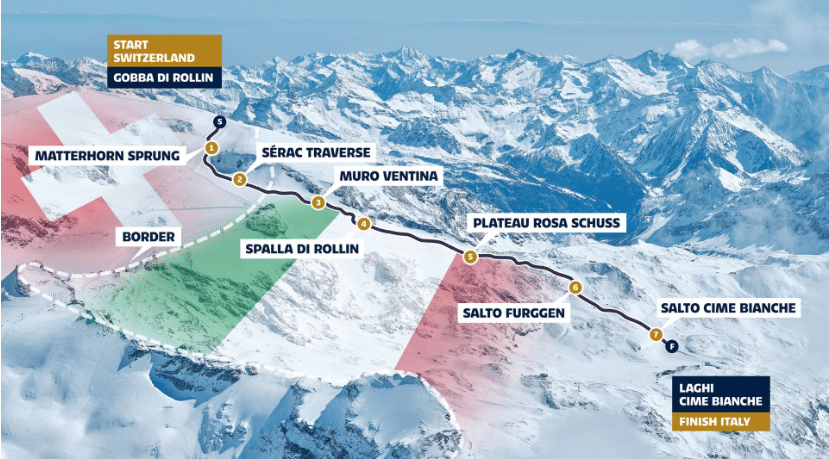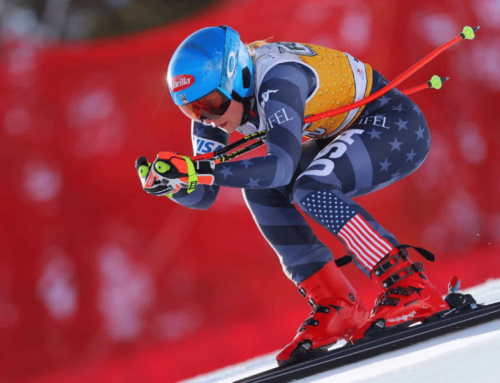Zermatt – Cervinia races scheduled to open 2023-24 speed season
The 2024 Alpine World Cup race calendar hasn’t been finalized, but the Speed Opening is already confirmed: men will race on November 11th and 12th, and the women on the 18th and 19th, 2023.
The four downhill races hosted in the shadow of the Matterhorn will cross from Switzerland into Italy. The event had been scheduled to debut last season but had to be canceled. After the 2022 false start, let’s learn more about this year’s event and if it will likely occur.
An Ambitious Plan
On November 30th, 2019, the management of the ski lift companies from Zermatt SUI and Cervinia ITA met for their annual pre-season meeting. The two areas, located under one of the world’s most iconic mountains, form a ski resort among the largest in the European Alps. Combined, the two offer an impressive 360km of groomed slopes.
Since 2018, a modern cable car has taken skiers and pedestrians from the traditional Swiss mountain resort village of Zermatt to the glacier at 12739 feet (3883m) above sea level. The scenic trip in Swarovski-designed cabins is quick and comfortable.
At the 2019 meeting, the director of the Italian lift company, Federico Maquignaz, proposed hosting a unique World Cup race in 2023, coinciding with the opening of the new gondola from the Italian side. A gondola that would reach the top of the glacier from Cervinia, Italy. The “Matterhorn Alpine Crossing” was undoubtedly an ambitious proposal.
Franz Julen, CEO of the lift company Zermatt Bergbahnen AG, “knew in five seconds that it was the right idea. Not only for our ski resort but for skiing, tourism, the industry and the business related to it, for our sport.”
Julen is a successful entrepreneur and manager with a strong ski racing background. He followed the career of his brother Max, the 1984 Olympic giant slalom champion, and knows what it takes to organize a World Cup event.
FIS Pushes Forward with Organizers
The International Federation, FIS, immediately welcomed the proposal, —however, President Johan Eliasch, a longtime friend of Julen, wanted the race on the 2022 schedule. Without any available time a European Cup or any type of “test event” would not occur. The chance to compete in the Autumn without conflicting with different events and the opportunity to add more speed races to the circuit was too good to postpone.
Eliasch describes the project, “Zermatt-Cervinia does not only enable an earlier season opening for all our speed athletes but also makes history with the start of the races in Switzerland and the finish in Italy. Also, it is uniquely located in the shadow of the iconic Matterhorn/Cervino. The innovative concept is the best way possible to promote our sport.”
The FIS and the Italian and Swiss Federations created an organizing committee that secured funding and their efforts would produce the first cross-border race in World Cup history. Interestingly, destiny determined that the 2022 opening speed races would be canceled, so the original desire to wait for the 2023 opening of the new Italian super lift ultimately happened.
According to expectations, the new gondola Matterhorn Glacier Ride II will be inaugurated this summer on July 1st. The new Italian lift required a 60 million Euro investment which matches the 60 million needed to build its twin Swiss lift in 2018, the Matterhorn Glacier Ride.
Skeptics remain
Some skiers and coaches have doubts concerning the Zermatt – Cervinia opening speed events. They’re concerned that it is too early in the season, too demanding because of the altitude, and too difficult to host because of the conditions on the glacier. They also argue that the course is too exposed to the wind and is too flat and long. Another concern is that too many training days will be lost in the prep period.
Julen and his team have listened to the critics. “We don’t underestimate the challenges. When you provide something new, it’s normal that there are doubts. Last season the race was unlucky; we just missed having enough snow on the final pitch. But we know what we’re doing. We will offer multiple training opportunities for the teams, which I’m confident will be valued and appreciated.”
A Course Designed by an Olympic champion
Respecting the safety standards, homologation parameters and having a desire to deliver a spectacular sports event, the FIS and the organizing committee appointed the 2010 Downhill Olympic champion Didier Défago as the course designer. Défago is an expert in downhill creation and has designed other major event downhill courses.
Notably, the former Swiss ski racer has been involved since the conception of the “Gran Becca.”
“First time we met with the organizers, they had in mind to have the start as high as possible and the finish as low as possible, below Cime Bianche. However, I think a very long downhill isn’t necessarily good. What makes it good is being complete. We dedicated significant time to this concept phase, discussed it with ski experts, and agreed to look for variations instead of working on the length. We shared a concept, a philosophy, to create the course.”
Défago developed the slope design step by step. “I focused on the higher part, which is in Swiss territory, until Testa Grigia. That was my first assignment, evaluating the potential of that section because, originally, the Italian part was supposed to remain as it was. Later, we also reviewed that part, studying the lines and completed some minor work.”
Designing The Course was Challenging
Creating a course on a glacier hasn’t been an easy challenge: “Two-thirds of the Gran Becca exists on a glacier. There’s natural ice and snow, and the terrain moves much more than elsewhere. However, in the last section, there will be artificial snow. Facing different surfaces will be a challenge for the racers.”
Once the new Italian gondola is open, the major work planned for the course is preparing the start area with a solar-powered start house and removing the old poma lift. However, the most important job will be filling the dangerous crevasses in the ice.
Hopefully, in November, the men will race the Gran Becca as Défago designed it. “Last year, the top section wasn’t accessible as the new lift wasn’t ready. It’s steep, allowing racers to gain significant speed at the beginning of the run. I expect the winner to be a complete downhiller. You have to be fast on the two gliding sections and take some risks around the area between Switzerland and Italy. It’s very technical there and on the Sérac Traverse and the Furggen Jump. I’m really looking forward to watching the first racer on this course. These events will do good for our sport,” concludes Défago.
New Year, New Strategies
Last year, the summer was the warmest ever recorded in Europe, and due to the lack of snow in the course’s final section, the races were canceled. “There are two relevant differences from last year,” reveals Race Director Rainer Senoner. “The races are planned to occur a couple of weeks later than they were in 2022. Last season the women were scheduled for October 29th-30th, and this year the men are scheduled to race on November 11th-12th. The women will race on the following weekend. This will hopefully create an opportunity for cooler temperatures and more snowmaking.”
According to Senoner, the second advantage is the different strategy for snow farming: “Last year, we could store only natural snow; there was no time or possibility to create a storage of artificial snow. This season, the amount stored will be larger and we know that artificial snow resists melting even better.” The snow reserves will be divided into five locations along the top of the course, not to be moved around, and covered with special blankets successfully tested last summer. The blankets allow 70% of the snow deposits to survive the summer months.
Weather History Provides Optimism
“Bad weather and wind could be big threats, especially at higher altitudes, but we aren’t too worried if we look at the weather records of previous years. They confirm that the conditions are generally good during the specific time period chosen for the competitions. However, poor visibility, snow and wind remain a significant challenge in running a downhill race. There aren’t any guarantees, but the historical weather data gives us an additional reason to be optimistic.”
Senoner isn’t a rookie World Cup race director. He was recruited with a small team of experienced course technicians directly from another race organization, more precisely from Gröden, where he served as race director for many years before being elected President of the organizing committee. “Finding a local person willing to take on this commitment and responsibility is difficult. Uniquely, these race events will debut directly on the World Cup scene without a test event. We were contracted to offer our experience from Gröden, begin the course construction and help train a local team and race director for the following editions.”
Now we’ll have to wait until November to know if 2023 will be the year of the first cross-border races in World Cup history.






















